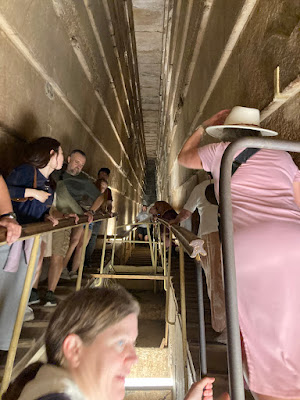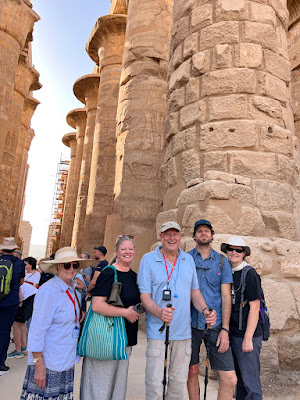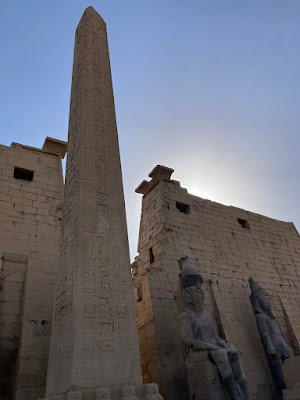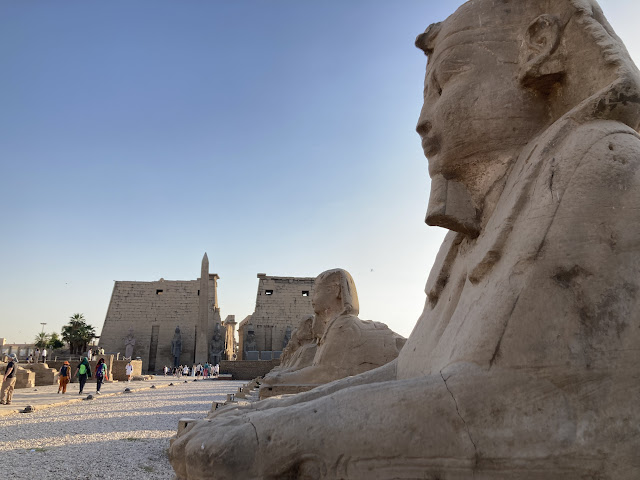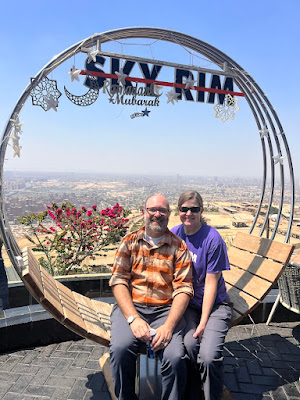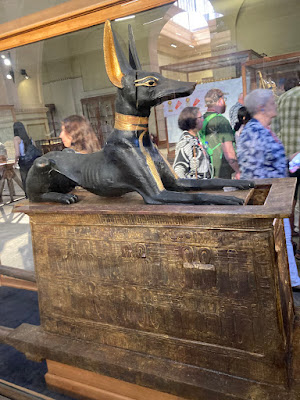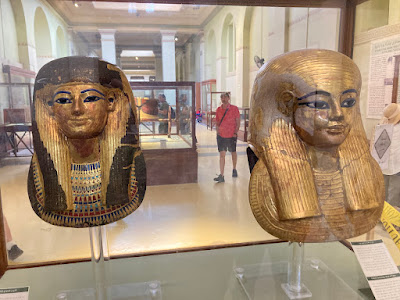Egypt: April 2024
Wednesday, March 27 and Thursday, March 28:
We drove to Seattle, arriving around 4:30pm. We met up with Brian and Noelle and Matt and
Mariah. Our Turkish Airlines flight was
supposed to take off at 7:40pm, but was almost 30 minutes late. The almost 12-hour flight was for the most
part uneventful. We flew over Greenland
and then over Poland, Ukraine, and then landed in Istanbul. It took forever to taxi to our gate. We only had about 30 minutes to our next
flight, so we had to run to our next flight.
On the plane they gave us the gate number, but in the airport we
couldn’t find that flight listed, so we went to another gate that had a flight
going to Cairo at the same time, thinking maybe that was our flight. Once we got there, they told us the original
gate was the actual one, so we had to run over to that terminal and gate. Luckily, all of us (and our bags) made it
there on time. The two-hour flight to
Cairo was somewhat bumpy, but at least they fed us a meal! Upon arriving in Cairo, we were met by a Gate
1 representative that helped us with our visas and bags. We then took a van through Cairo and finally
got to our hotel around 9:30pm. We were
tired and went to bed.
 |
| Somewhere over Greenland |
 |
| Arriving in Cairo at night |
 |
Our hotel in Cairo
|
Friday, March 29:
We got an early start this morning and took a bus out to the
great pyramids in Giza. It is amazing
how close the pyramids are to the rest of the city. Our first stop was the great Pyramid of
Cheops (or Khorfu). After an explanation
of the pyramids by our guide, Walid, we had some free time to wander around the
pyramid. At almost 500 feet tall, it was
the tallest man-made structure on earth for several millennia. Brian, Noelle, Becky, and I bought an extra
ticket to go inside the pyramid. It was
very tight, crowded, and hot inside the pyramid. We made our way up to the burial chamber
where the broken sarcophagus was the only thing left after tomb raiders stole
everything else. The burial chamber was
very plain, with no decorations. After
we made our way out of the pyramid, we walked around the perimeter and admired
the sheer size of the object. It took
over two million blocks to build it, each weighing 20-30 tons! We were eventually able to view the other
pyramids as well.
 |
| Cairo in the morning |
 |
| Outside the great pyramid |
 |
| The Great Pyramid |
 |
| Inside the Great Pyramid |
 |
| Climbing inside the pyramid |
 |
| Burial Chamber inside the pyramid |
 |
| The pyramids with the city of Giza in the distance |
Next we drove past the other two large pyramids and stopped at
the panorama point where you have a great view of all three major
pyramids. Becky and I decided to pay a
little extra to ride and get a picture on a camel. We were able to get a family picture,
recreating the one Terry and Jennifer did back in the 1980’s.
 |
| The obligatory camel ride |
 |
| Family photo |
Our next stop was at the Sphinx, which is right down the road
from the pyramids. The Sphinx is
literally right on the edge of town, with a KFC and Pizza Hut across the
street! After touring a temple right
next to the Sphinx, we were able to walk close to it and take pictures. It was honestly not as big as I imagined it
would be.
 |
| Profile of the Sphinx |
We then drove south for a bit, had lunch at an outdoor
restaurant, then went to the great step pyramid of Djosser in Saqqara. This was the first attempt at a pyramid and
the oldest brick structure in the world.
We walked around the site and then Walid took us inside some of the
ancient tombs to get some of our first looks at hieroglyphs. Saqqara is still an active archeological
site, so many areas were closed off.
After Saqqara we stopped at a carpet factory to watch how they hand-make
carpets. We didn’t buy anything, but
several family members did. At the end
of a long day, we drove back to Cairo to our hotel where we had dinner with
Walid and the rest of our Gate 1 group. There
are only 17 in our group, 11 of which are part of our family.
 |
| Lunch stop |
 |
| Great Step Pyramid of Djosser |
 |
| Ruins at Saqqara |
 |
| Inside a tomb |
 |
| Visiting a rug factory |
 |
| The store at the carpet factory |
Saturday, March 30:
Today was an early start at 3:30am for breakfast and on the bus
by 4:30am. We arrived at the Cairo
airport around 5am and boarded our flight to Luxor at 7:05am. Since they had changed to a different plane,
they bumped almost our whole group to business/first class. Sadly, it was only a one hour flight, so we
didn’t have that much to enjoy the comfort (they did, however, feed us a meal,
on a one hour flight! Once we touched
down in Luxor we drove over to our cruise ship, checked into our room and took
a nap. The lunch buffet was very good,
with a mix of Egyptian food and other selections.
 |
| Landing in Luxor |
 |
| Our cabin on the ship |
 |
| Pool on the top deck of our ship |
In the afternoon we visited the temple of Karnak. Karnak is one of the largest religious complexes in the world. It was built and added to for over 2,000 years. All over the site there were unique ruins to look at. The entryway was flanked by rows of rams. There were a pair of obelisks that are some
of the last ones remaining in Egypt (there are only five left in the country;
the rest have been removed and “sent” to other countries like France and the
Vatican). I was amazed at the large
robust columns in the Hypostyle Gallery.
Each massive column was gorgeously painted with colors so vibrant that
they looked like they were painted yesterday.
Our tour guide Walid continued to show us around the site, ending by the
sacred lake and a large carving of a scarab beetle. Legend says if you do two rotations around
the beetle you will return to Egypt; if you do three then you will get a new
wife (I only did two). From there we
were given free time to wander around the site.
 |
| Entrance to Karnak Temple |
 |
| Mud ramp showing how they built the pylon (wall) |
 |
| Large columns in Karnak Temple |
 |
| Paintings on the columns at Karnak Temple |
After Karnak we made a stop at a papyrus factory that produced
authentic papyri with unique paintings on them.
Many were very beautiful while some were somewhat cheesy. Toward the end of the afternoon we came back
to our ship and had dinner, followed by a belly dancer and a whirling dervish
demonstration.
 |
| Papyrus factory |
Sunday, March 31:
Today was another early start so we could beat the desert
heat. By 6am we were crossing the Nile
and heading over to the Valley of the Kings.
The Valley of the Kings was used for centuries by the Egyptians to bury
their royal family members. The location
was kept as secret as possible to prevent the tombs from being raided. Sadly, most were looted of their treasures,
some as soon as they were sealed up. As
a group we toured the tombs of Ramses IV, Ramses IX, and Ramses III. The artwork in each of these tombs was
amazing and was so vibrant it looked like it was painted yesterday, not several
thousands of years ago!
 |
| Breakfast pastries on our ship |
 |
| Watching hot air balloons take off over the Valley of the Kings |
 |
| 3D map of the Valley of the Kings |
 |
| Valley of the Kings |
 |
| Entrance to one of the tombs |
 |
| Inside one of the tombs in the Valley of the Kings |







We then had some free time to explore the area. Becky and I and a few others bought the extra
tickets to go see King Tutankamen’s tomb.
Though his tomb is one of the smallest ones in the Valley and hardly
decorated, it is probably the most famous due to the historic discovery of the
tomb in 1922, along with all of the treasures still intact. I had read and studied about King Tut almost
my whole life, so this was one of the highlights of the trip. To top it off, King Tut’s mummy is still kept
in the tomb, albeit in a glass coffin instead of the original (which is in the
museum in Cairo). It was amazing to step
up close and see the actual King Tut, or what is left of him. After Tut’s tomb, we went over to the tomb of
Ramses V and VI. This tomb was a lot
longer than some of the others and had the sarcophagus still at the bottom,
though it had been severely damaged by looters.
Becky and I then walked around the valley, stopping to watch an
archeological dig occurring alongside one of the tombs. The temperature continued to rise, so it was
time to move on to our next stop (I couldn’t imagine being in the Valley of the
Kings in the middle of summer).
 |
| Outside King Tut's Tomb |
 |
| King Tut's mummified body |
 |
| King Tut's burial chamber |
 |
| King Tut's mummy |
 |
| Tomb of Ramses V and VI |
 |
| Archeological dig in the Valley of the Kings |
Our tour guide Walid then took us to an Alabaster factory to
watch them create pots, vases, statues, etc. out of Alabaster. After that we drove over to the temple of
Queen Hatshepsut. The temple is on the
back side of the Valley of the Kings and is very distinct and has a different
style than other Egyptian temples. It is
made of several layers, the last of which goes into the mountainside. When we first arrived there our tour guide
had several of us on the tour help act out the family history of Queen Hatshepsut
to show how she came to power. We then
had free time to wander around the temple.
 |
| Alabaster factory |
 |
| Temple of Queen Hatshepsut |
 |
| Colossi of Memnon |
After
a brief stop at the Colossi of Memnon, we made our way back to the boat. After lunch we took a nap while the boat
started making its way upriver. Later in
the afternoon most of us went up to the top deck to watch as our boat went
through the locks at Esna, where we stopped for the evening.
 |
| Relaxing on the boat |
 |
| Going through the locks at Esna |
 |
| Sunset in Esna |
Monday, April 1:
Since
we had to wake up very early the last several days, today was a sleep-in
morning. After breakfast we gathered in
the ship’s lounge to listen to our guide Walid discuss current events in Egypt. He was very open about the events leading up
to the Arab Spring and the events that have happened since. It was interesting to hear his perspective on
his country’s history. Walid also
discussed different aspects of Egyptian culture.
 |
| Cruise ships docked in Esna |
 |
| Cruising along the Nile |
After
some more relaxing as the ship made its way up the Nile, we stopped at the Kom
Ombo Temple. Kom Ombo is dubbed the
“double temple” since it is dedicated to two gods: Sobek the crocodile-headed
god and Haroeris. There were a lot of
cruise ships here. In fact, we had to
walk through five ships just to get off of ours. Some of the highlights at this temple were an
ancient calendar that showed the flooding dates of the Nile and carvings that
showed ancient medical instruments.
Right outside the temple is a very small museum that contains several
mummified crocodiles that were left at the temple as offerings. As the sun started to set, we made our way
back to the ship and continued our journey along the Nile. Dinner tonight was an Egyptian buffet, with
very flavorful food. The entertainment
after dinner was some Egyptian music, but it was very loud. We could hear it in our cabin.
 |
| Temple of Kom Ombo |
 |
| Calendar showing the flood days of the Nile |
 |
| Carvings of ancient medical tools |
 |
| Mummified Crocodiles |
 |
| Sunset at Kom Ombo |
 |
| Leaving Kom Ombo |

Tuesday, April 2:
This
morning was another very early start, this time to get on our bus for a
three-hour ride from Aswan, across the Sahara Desert, and then to the ruins of
Abu Simbel. We stopped briefly at a rest
area to take pictures in the desert (and watch a bunch of Chinese tourists
almost get hit as they took selfies in the middle of the road).
 |
| Leaving our boat early in the morning |
 |
| On the road to Abu Simbel |
We arrived in Abu Simbel around 8:30
am. The place was already full of
tourists, which was a bit surprising being that the location is somewhat remote
and only about 20 miles from the border with Sudan. The ruins and temples of Abu Simbel were
built by Ramses II for him and his wife Queen Nefertari. At
first sight the ruins are impressive.
Ramses’ temple is flanked by four giant statues of him. What is almost equally impressive is the
story of how these massive temples were saved from the rising waters of the new
Lake Nasser which was created by the Aswan High Dam. In the 1960’s, groups of engineers,
archeologists and more from several countries and UNESCO took the temples,
ruins, and most of the hillsides in which they were built block by block and
moved the temples higher up and above the water level. It was amazing to go inside the temples,
which are cut inside the hillside. The
new “hills” in which the temples are built are actually man-made concrete domes
covered by dirt and rock. If you didn’t
know this, you wouldn’t be able to tell.
The site sits right alongside Lake Nasser, with beautiful views up and
down the lake. Becky and I looked around
and inside both temples. There were
hoards of tourists inside both temples, so much so that it was hard to move
around and extremely hot and sweaty.
 |
| Approaching Abu Simbel |
 |
| Giant statues of Ramses II at Abu Simbel |
 |
| Diagram showing how they moved the temples |
 |
| Inside the temple |
 |
| The Temple of Ramses II in the background and the Temple of Nefertari in the foreground |
After
wandering around some more, we made our way back to the bus for the three-hour
ride back to Aswan. Back at our ship we
had lunch and relaxed for the rest of the evening. After dinner we went to a show in the lounge
which featured Nubian dancers and music.
 |
| Driving through the Sahara Desert |
 |
| Nubian Dancers |
Wednesday, April
3:
To
beat the heat, we were off again by 7am.
Our first stop was the Aswan High Dam, one of the largest dams in the
world. By building the dam, Egypt was
able to control the flooding of the Nile (for better or worse), create
electricity, and create Lake Nasser, one of the largest man-made lakes in the
world for fresh water. Security was
tight on top of the dam. Any damage to
the dam would have devastating effects on the whole of Egypt (since most of the
population lives along the Nile).
 |
| Aswan High Dam |

After
the dam we made our way over to the bank of the Nile to catch a small boat out
to Philae Temple, which sits on an island.
Just like Abu Simbel, Philae temple was in jeopardy of being lost to the
waters of the new Lake Nasser. UNESCO
was able to move the whole temple block by block to a nearby island that was
slightly higher. Philae temple is
dedicated to the goddess Isis and was one of the last Egyptian temples to be
used. In fact, the last hieroglyphs were
carved here during the 6th century A.D. Others, such as the Romans and early
Christians used the temple for worship.
The whole island is very beautiful, with the ruins mixed in with palm
trees. By about 10 am the temperature
was getting very hot outside and it was time to catch our boat back to the
shore. It was very entertaining to watch
our boatman try to squeeze his boat in at the dock. There were tons of empty boats tied up, but
no one was willing to move. That didn’t
stop our boatman, who decided that the best option was to go full throttle,
full speed ahead and just continually ram his way in until a spot opened
up.
 |
| Taking the boat out to Philae Temple |
 |
| Philae Temple |
 |
| Our tour guide Walid |
 |
| Philae Temple |
 |
Leaving Philae Temple
|
 |
| Glass blower at the essential oils factory |
We then drove back into Aswan and went to a perfumery, where we sat and listened to an explanation of essential oils and had an opportunity to try a few. Becky bought a little bit of oil and several family members bought a lot. After getting our fill of smells, we went back to the ship for lunch and a nap.
 |
| Sampling essential oils |
 |
| This guy didn't know what he was getting into when he volunteered to rub Terry's feet! |
In
the late afternoon we went to the Aswan market.
Our first stop was a spice shop, where we watched a quick demonstration
on spices and where they come from. We
then had some free time to wander through the market (which wasn’t that
big). The vendors were extremely
annoying and would not leave you alone.
They wouldn’t even give you a starting price to bargain and would follow
you out of the store if you did not buy something. Terry and I found some galabeyas to wear for
the dinner party tomorrow night. We then
made our way back to the bus and drove the short drive back to the ship for the
evening.
 |
| Aswan Market |
 |
| Spices |
Thursday, April 4:
Our
ship left Aswan early this morning and started heading back down the Nile
toward Luxor. After lunch we visited the
Edfu temple, which is one of the best preserved temples. The temple was covered for long periods by
shifting sand, which protected its walls and carvings. Since we were there at mid-day, we pretty
much had the place to ourselves, but it was blazing hot. Our tour guide Walid had a few of us act out
a story on the genealogy of some of the Egyptian Gods. The temple at Edfu is dedicated to the falcon
god Horus, and there are large statues of Horus here as well.
 |
| Falucca on the Nile |
 |
| The MS Sudan, the same ship that Agatha Christie wrote "Death on the Nile" on |
 |
| Edfu Temple |
By
the end of our time looking around the temple, we were very hot and ready to
head back to the ship. In the evening we
had our Egyptian dinner and party, with everyone dressing up in their Egyptian
outfits. After dinner we went to the
lounge where Walid and some of the crew members taught us some dances. It was a lot of fun and the crew members were
having a great time as well.
 |
| Egyptian Night costumes |
 |
| Family photo |
 |
| Our tour guide Walid |
 |
| The dining room on the ship |
 |
| Main lobby |
 |
| Sitting area |
 |
| Lounge |
Friday, April 5:
We
arrived in Luxor late last night and awoke to the sights of the hot air
balloons taking off over the west bank of the Nile. In the morning several family members took a
taxi into town and visited the Luxor Museum.
The museum contains some amazing artifacts. It also houses the mummies of two kings. In the basement of the museum are statues
that were found in the 1980s, buried in the Luxor temple complex.
 |
| Luxor Museum |
 |
| Mummy at the Luxor Museum |
 |
| Ancient blueprint |
 |
| Classic taxi ride |
 |
| Our ancient taxi |
In
the afternoon we made our way over to the Luxor temple, one of the most famous
Egyptian temples. Luxor has been a place
of worship for 3,500 years, from the Egyptian, through the Romans, to
Christians, to Muslims now (there is a mosque built on the site). It was hot outside, but that didn’t stop the
hordes of tourists from coming to the temple.
We entered the complex, passing the giant statues of Rames II and an
obelisk. Once inside, Walid pointed out
different parts of the temple and which rulers built what. Toward the back of the area there is a space
where you can still see Roman paintings that were plastered over the earlier
Egyptian carvings. Archeologists had to
determine whether to leave the Roman paintings there or take them off to reveal
the older carvings. They decided to
leave them there. Becky and I looked
around the various parts of the temple and then walked out to the Avenue of the
Sphinxes, which is the ancient road that connected Luxor to Karnak temple. Toward the end of time at Luxor we went into
the gift shop and bought a statue of Surket, one of the goddesses that stood
around King Tut’s canopic jars. We spent
the rest of the evening on the ship talking with the family and packing up our bags.
 |
| Luxor Temple |
 |
| Mosque inside Luxor Temple |
 |
| Roman arch inside Luxor Temple |
 |
| Roman Frescos |
 |
| Avenue of the Sphinxes |
 |
| Sunset on the Nile |
 |
| Our statue of the goddess Surket |
 |
| Mosques lit up for Ramadan |
Saturday, April 6:
We had another
early morning breakfast, then caught our bus to the Luxor airport. After a quick hour-long flight on a small
plane to Cairo, we then took a short driving tour of Cairo and proceeded to
drive to the top of a hill with an amazing view over the area. We then stopped and ate lunch at a restaurant
that was right on the edge of the hill, with windows looking out over
Cairo. In the distance you could see the
pyramids (albeit it was a bit difficult with the smog).
 |
| Apartments in Cairo |
 |
| View of Cairo from the Restaurant |
 |
| Trash city hill |
Once
we made it back to our hotel, we had the rest of the afternoon to explore. Many of the family members decided to relax
at the hotel, while Becky and I took Terry and Jennifer and caught a cab over
to the Citadel. The Citadel is a large
fortress built upon a hill overlooking Cairo.
Several mosques and other important buildings make up the complex. We walked around, looking in an old mosque
and also at the military museum and a small jail. We then went over to the Muhammed Ali Mosque
and went inside. It was very beautiful
with stained glass and large chandeliers.
After the mosque we scheduled an Uber to come pick us up and waited and
waited for the car to arrive. Finally
the driver said he was at the bottom of the hill waiting for us. We quickly ran down and met him, only to find
out that his car was parked on the other side of a busy road. Our driver walked in front of us and did his
best to try to stop traffic.
Fortunately, we made it across alive (most cars don’t stop for
pedestrians and there really aren’t any “lanes” of traffic).
 |
| The Citadel |
 |
| Inside one of the mosques |
 |
| Military museum |
 |
| Muhammed Ali Mosque |
 |
| View of Cairo with the pyramids in the distance |
 |
| Inside the Muhammed Ali Mosque |
Our
next stop was the Khan el-Khalili, one of the largest markets in Cairo. The market is also one of the oldest in the
world, starting as a spice market in the 1300’s. Terry and Jennifer found a restaurant to sit
at while Becky and I wandered the market looking for goods. Becky got to hone her bargaining skills. Since we were visiting during Ramadan, at
sunset everything stopped as people came out of shops and houses to sit down at
long tables set up in the streets to eat and break their fast. It was a unique event where we really got to
see the true Egypt. After buying a few
things, we caught a taxi back to our hotel. For dinner, Becky and I went out
and found a local place making excellent and cheap shawarmas. We were the only locals around, which isn’t
always a bad thing.
 |
| Khan el-Khalili Market |
 |
| Entrance to our hotel in Cairo |
 |
| View from our hotel room |
Sunday, April 7:
First
off this morning we went to the world-famous Egyptian Museum in downtown Cairo.
The museum contains some of the finest and most famous Egyptian Artifacts in
the world. Eventually all of the
artifacts will be moved to the new Grand Egyptian Museum, but for the time
being most are still here. For the first
half, our guide Walid took us around and showed us some of the more famous
artifacts and told us their history. We
wound up to the second floor and to the famous King Tut exhibit. We had to wait in line to enter and see some
of the more famous and priceless artifacts that were kept in a special
room. Of course, there were big Egyptian
men in there yelling, “no stopping, keep moving, no photos”! We made our way around the room, pausing to
see Tut’s golden coffin and the most famous piece, his golden mask. It was truly amazing to see the mask up
close. The details on the mask were
exquisite. I’ve always wanted to see the
mask and I wish I had a bit more time to examine it. I wish I could have taken a picture, but then
again, I got to see it with my own eyes.
After that we walked around and looked at other artifacts from King
Tut’s tomb, such as his throne and some of his treasury boxes. We then had some free time to wander on our
own. Becky and I decided to go see some
mummies and some mummified animals. The
museum is vast and it is hard to take it all in. Some rooms were filled with coffins stacked
from floor to ceiling. Others had large
statues or pieces of papyrus that stretched across the walls. When we were finally finished in the museum
we went to a restaurant on a boat that was docked along the bank of the Nile.
 |
| Egyptian Museum |
 |
| The Scribe |
 |
| Papyrus |
 |
| Statue from King Tut's tomb |
 |
| King Tut's canopic jars |
 |
| King Tut's Throne |
 |
| Box belonging to King Tut |
 |
| Statue of King Tut and his sandals |
 |
| Mummy |
 |
| Mummified baboon |
 |
| Mummified dog |
 |
| Mummified small dog |
 |
| Oldest artifact found in Egypt, almost 7,000 years old! |
In
the afternoon we went back to the Khan el-Khalili market as a group and had
some time to explore more of the shops.
We decided to buy a few more things, giving Becky one more chance to
bargain for some trinkets. Since we were
there earlier in the day, the market wasn’t nearly as busy as it was the night
before.
 |
| Cairo traffic |
 |
| Our police escort |
 |
| Khan el-Khalili Market |
 |
| Mosque |
 |
| Public market |
 |
| Police van, Mad Max version |
Back
at the hotel we gathered for our farewell dinner. We had one more chance to swap travel stories
with the other members of our group and say goodbye to them and our amazing
guide, Walid. Walid gave us a large
group picture, along with a carved scarab beetle. We then went back to our room to try and fit
everything into our bags!
Monday, April
8:
Most
of the family left for the Cairo airport together, since we were flying
together back to Seattle. Fortunately,
we had a non-eventful flight to Istanbul, where we actually had a long enough
layover that we did not have to run to our gate like last time. The flight from Istanbul to Seattle was
somewhat uneventful, even though I had a really smelly, large guy from India
sitting behind me that somehow managed to bump my seat every 20 minutes or so
for the entire 12-hour flight. We were flying home right in the middle of the total Solar
Eclipse that crossed the U.S., but we were too far north to see it. When we arrived in Seattle customs and
immigration was practically empty and took us less than five minutes. We said our goodbyes to the rest of the
family, got in our car and made the drive back home, tired and ready for work
the next day.

































































































































